Notifications


by [url=https://www.ganoksin.com/member/edmundmassow/]Edmund Massow[/url]
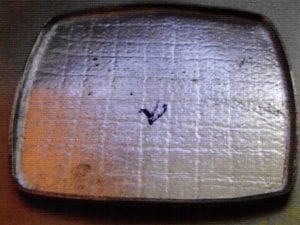 [/url]
Fig 1. Bend over frame made from silver sheet
You can enamel directly onto the frame or you can use it to glue an enameled plate in. If you want to enamel directly to the frame, do not rivet the findings as the enamel may crack or pop off on or around the rivets.
[/url]
Fig 1. Bend over frame made from silver sheet
You can enamel directly onto the frame or you can use it to glue an enameled plate in. If you want to enamel directly to the frame, do not rivet the findings as the enamel may crack or pop off on or around the rivets.
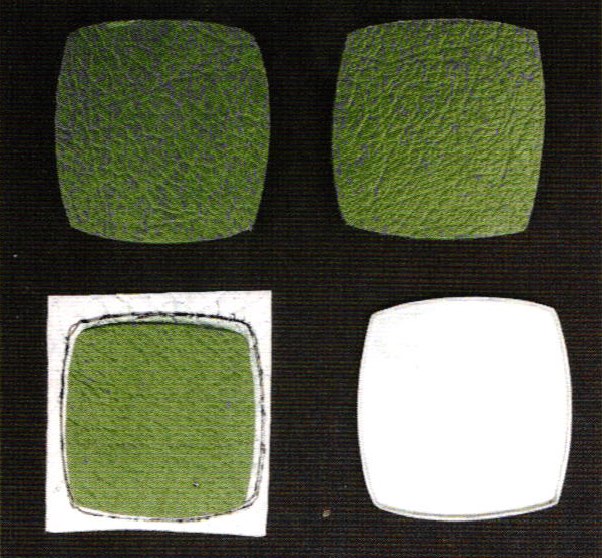 [/url]
Fig 2. Top: two identical plastic cut outs, Bottom left: shape transferred to metal with enlargement of shape traced onto metal; bottom right silver sheet.
Transfer the outline of one of the plastic shapes to a 0.7 – 0.8 mm fine silver sheet. Enlarge the size of the shape by adding an extra 2 – 3 mm to the outline or perimeter of the shape as this will become the bent over “frame” of the shape. (Fig. 2). If you want to enamel directly on the frame, you need only a rim height of about 1 mm. However, you will still need at a minimum 2 mm excess or you will not be able to bend it over. All types of shapes are possible with this technique, not only round or square (Fig. 3).
[url=https://www.ganoksin.com/wp-content/uploads/2016/07/image_3-28-1.jpeg]
[/url]
Fig 2. Top: two identical plastic cut outs, Bottom left: shape transferred to metal with enlargement of shape traced onto metal; bottom right silver sheet.
Transfer the outline of one of the plastic shapes to a 0.7 – 0.8 mm fine silver sheet. Enlarge the size of the shape by adding an extra 2 – 3 mm to the outline or perimeter of the shape as this will become the bent over “frame” of the shape. (Fig. 2). If you want to enamel directly on the frame, you need only a rim height of about 1 mm. However, you will still need at a minimum 2 mm excess or you will not be able to bend it over. All types of shapes are possible with this technique, not only round or square (Fig. 3).
[url=https://www.ganoksin.com/wp-content/uploads/2016/07/image_3-28-1.jpeg]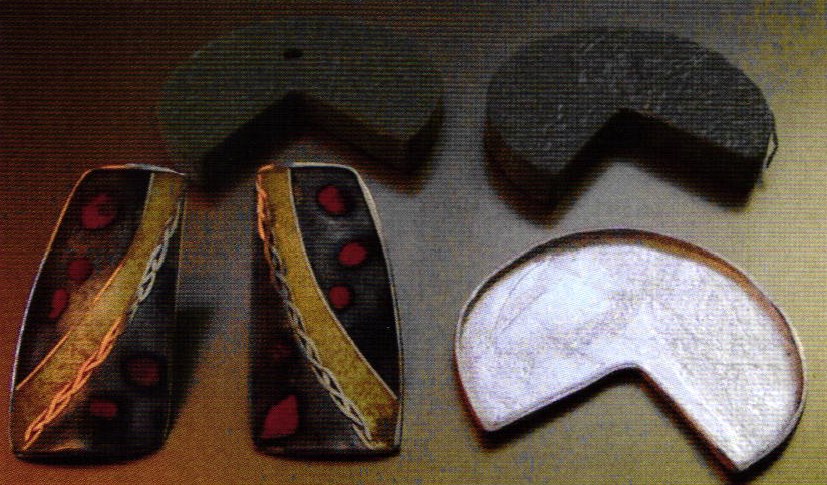 [/url]
Fig 3. Various shapes made with this process
Make a ‘sandwich’ with one plastic sheet on either side of the silver sheet. Make sure the excess sticks out uniformly on all sides of the ‘sandwich.’ Clamp the ‘sandwich’ in a vice (Fig. 4).
[url=https://www.ganoksin.com/wp-content/uploads/2016/07/image_4-24-1.jpeg]
[/url]
Fig 3. Various shapes made with this process
Make a ‘sandwich’ with one plastic sheet on either side of the silver sheet. Make sure the excess sticks out uniformly on all sides of the ‘sandwich.’ Clamp the ‘sandwich’ in a vice (Fig. 4).
[url=https://www.ganoksin.com/wp-content/uploads/2016/07/image_4-24-1.jpeg]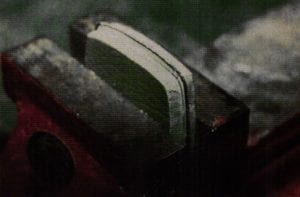 [/url]
Fig 4. Sandwich clamped in vice
Hammer the silver rim excess over with a mallet or other ‘soft’ hammer to one side of the plastic sheet. Try not to bend the rim over in one step, do this in about three steps so the rim doesn’t build up folds (Fig. 5).
[url=https://www.ganoksin.com/wp-content/uploads/2016/07/image_5-22-1.jpeg]
[/url]
Fig 4. Sandwich clamped in vice
Hammer the silver rim excess over with a mallet or other ‘soft’ hammer to one side of the plastic sheet. Try not to bend the rim over in one step, do this in about three steps so the rim doesn’t build up folds (Fig. 5).
[url=https://www.ganoksin.com/wp-content/uploads/2016/07/image_5-22-1.jpeg] [/url]
Fig 5. Hammering over excess metal to make frame
Remove the silver sheet from the plastic. File away the little folds, other roughness and the top of the rim as needed. If you are going to enamel directly on the silver frame, file down the rim to a height of about 0.8 to 0.9 mm.
If you want to make a pendant, drill a hole in the silver sheet. If the work piece is to be stoned after enameling, it is best to dome the metal frame a bit. Do not dome on a dapping block, but on a stake.
If you want to make a brooch, now is the time to solder the findings on the back. If you are not comfortable soldering, do the following: If you want to glue round ‘footed’ findings (Fig. 6), lay two round, formed silver rings made from one mm fine or sterling silver wire to the back of the work piece frame.
[url=https://www.ganoksin.com/wp-content/uploads/2016/07/image_6-16-1.jpeg]
[/url]
Fig 5. Hammering over excess metal to make frame
Remove the silver sheet from the plastic. File away the little folds, other roughness and the top of the rim as needed. If you are going to enamel directly on the silver frame, file down the rim to a height of about 0.8 to 0.9 mm.
If you want to make a pendant, drill a hole in the silver sheet. If the work piece is to be stoned after enameling, it is best to dome the metal frame a bit. Do not dome on a dapping block, but on a stake.
If you want to make a brooch, now is the time to solder the findings on the back. If you are not comfortable soldering, do the following: If you want to glue round ‘footed’ findings (Fig. 6), lay two round, formed silver rings made from one mm fine or sterling silver wire to the back of the work piece frame.
[url=https://www.ganoksin.com/wp-content/uploads/2016/07/image_6-16-1.jpeg]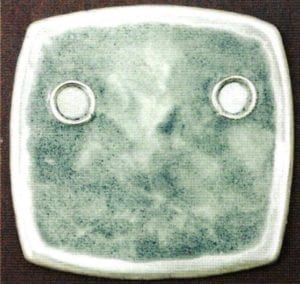 [/url]
Fig 6. Applying enamel around silver rings
Apply wet enamel to the back. The enamel must fasten the rings from the outside, keeping the inside of the rings free from enamel (Fig. 6). After drying, fire the enamel. Now you can enamel the front side. After all enameling is done, glue the findings into the rings (Fig. 7).
[url=https://www.ganoksin.com/wp-content/uploads/2016/07/image_7-13-1.jpeg]
[/url]
Fig 6. Applying enamel around silver rings
Apply wet enamel to the back. The enamel must fasten the rings from the outside, keeping the inside of the rings free from enamel (Fig. 6). After drying, fire the enamel. Now you can enamel the front side. After all enameling is done, glue the findings into the rings (Fig. 7).
[url=https://www.ganoksin.com/wp-content/uploads/2016/07/image_7-13-1.jpeg]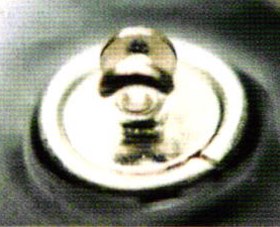 [/url]
Fig 7. Finding glued into ring
Because the rings are very small, it would be easier to use a commercially manufactured bar pin (Fig. 8). For these, make a little rectangular box shape from silver wire and secure with enamel as explained above, again, keeping the inside of the box free of enamel. These wire rings and boxes have no technical function, their function is to make a more finished look to the back.
[url=https://www.ganoksin.com/wp-content/uploads/2016/07/image_8-11-1.jpeg]
[/url]
Fig 7. Finding glued into ring
Because the rings are very small, it would be easier to use a commercially manufactured bar pin (Fig. 8). For these, make a little rectangular box shape from silver wire and secure with enamel as explained above, again, keeping the inside of the box free of enamel. These wire rings and boxes have no technical function, their function is to make a more finished look to the back.
[url=https://www.ganoksin.com/wp-content/uploads/2016/07/image_8-11-1.jpeg]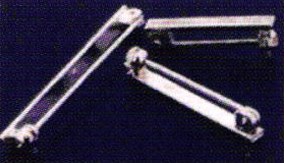 [/url]
Fig 8. Commercial bar pins
If you don’t want to glue findings onto the frame, you can make rivet findings. Most of the commercially made bar pins have two holes in the base plate. If they do not, you will have to drill them yourself. Transfer the hole placement on the bar pin to match them to the metal frame. For brooches, the findings (bar pins) should always be fastened in the upper third of the brooch, otherwise the brooch will fall in front when it is worn.
[url=https://www.ganoksin.com/wp-content/uploads/2016/07/image_9-6-1.jpeg]
[/url]
Fig 8. Commercial bar pins
If you don’t want to glue findings onto the frame, you can make rivet findings. Most of the commercially made bar pins have two holes in the base plate. If they do not, you will have to drill them yourself. Transfer the hole placement on the bar pin to match them to the metal frame. For brooches, the findings (bar pins) should always be fastened in the upper third of the brooch, otherwise the brooch will fall in front when it is worn.
[url=https://www.ganoksin.com/wp-content/uploads/2016/07/image_9-6-1.jpeg]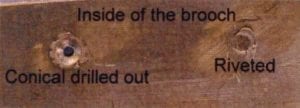 [/url]
Fig 9. Conical drill hole for riveting
Both the holes of the bar pin and the frame plate must have the same diameter as the wire you make the rivets from. To give the rivets more bearing surface, drill holes conical with a ball drill bit. (Fig. 9). Drill out half of the frame metal sheet and the bar pin finding plate thickness.
[url=https://www.ganoksin.com/wp-content/uploads/2016/07/image_10-5.jpeg]
[/url]
Fig 9. Conical drill hole for riveting
Both the holes of the bar pin and the frame plate must have the same diameter as the wire you make the rivets from. To give the rivets more bearing surface, drill holes conical with a ball drill bit. (Fig. 9). Drill out half of the frame metal sheet and the bar pin finding plate thickness.
[url=https://www.ganoksin.com/wp-content/uploads/2016/07/image_10-5.jpeg]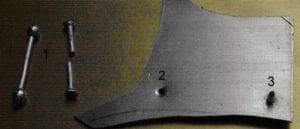 [/url]
Fig 10. Melt both wire ends to a ball
Cut a 3 cm long round fine silver wire. The wire must have the same diameter as the drill holes in both the metal plates (bar pin finding and frame metal plate). Melt both wire ends to a small ball and divide the wire in the center (Fig. 10). File the top 2/3 off of both balls (Fig.11).
[url=https://www.ganoksin.com/wp-content/uploads/2016/07/image_11-5.jpeg]
[/url]
Fig 10. Melt both wire ends to a ball
Cut a 3 cm long round fine silver wire. The wire must have the same diameter as the drill holes in both the metal plates (bar pin finding and frame metal plate). Melt both wire ends to a small ball and divide the wire in the center (Fig. 10). File the top 2/3 off of both balls (Fig.11).
[url=https://www.ganoksin.com/wp-content/uploads/2016/07/image_11-5.jpeg]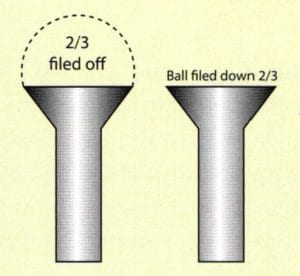 [/url]
Fig 11. File top of ball, rivet
Align the bar pin finding holes to the holes on the metal frame.
[url=https://www.ganoksin.com/wp-content/uploads/2016/07/image_12-5.jpeg]
[/url]
Fig 11. File top of ball, rivet
Align the bar pin finding holes to the holes on the metal frame.
[url=https://www.ganoksin.com/wp-content/uploads/2016/07/image_12-5.jpeg]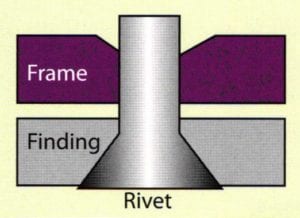 [/url]
Fig 12. Thread rivet through finding and bolt frames
Thread the rivet(s) through the bar pin holes so that the rivet head is needle side of the bar pin finding and the wire is protruding through the hole(s) in the silver metal frame. Cut the wire so that only about 0.5 mm is protruding above the silver metal frame. Place the rivet head onto a hard base. Rivet the wire first with the hammer fin, then with the flat side of the hammer.
[url=https://www.ganoksin.com/wp-content/uploads/2016/07/image_13-4.jpeg]
[/url]
Fig 12. Thread rivet through finding and bolt frames
Thread the rivet(s) through the bar pin holes so that the rivet head is needle side of the bar pin finding and the wire is protruding through the hole(s) in the silver metal frame. Cut the wire so that only about 0.5 mm is protruding above the silver metal frame. Place the rivet head onto a hard base. Rivet the wire first with the hammer fin, then with the flat side of the hammer.
[url=https://www.ganoksin.com/wp-content/uploads/2016/07/image_13-4.jpeg]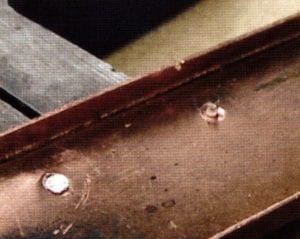 [/url]
Fig 13. Inner side of brooch frame with conical drilled hole and a bit of rivet on right side and on the left, the finished rivet
Hammer the rivet until the finding and silver frame are absolutely tight together. Now you can glue in the enamel work into the bent over frame.
[/url]
Fig 13. Inner side of brooch frame with conical drilled hole and a bit of rivet on right side and on the left, the finished rivet
Hammer the rivet until the finding and silver frame are absolutely tight together. Now you can glue in the enamel work into the bent over frame.
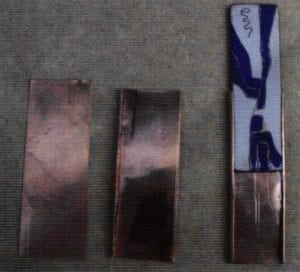 [/url]
Fig 14
You can use fine silver or a silver alloy about 0.5-0.7 mm thick for the frame. Transfer the outside lines of the finished enamel to the silver sheet. On the two opposite straight sides you need an extra of about the thickness of the finished enamel plus about 0.5 to 0.7 mm. For example: if the enamel is 2 mm thick, you need2 mm + 0.7 mm :2.7 mm extra on each straight side.
[url=https://www.ganoksin.com/wp-content/uploads/2016/07/image_15-3-1.jpeg]
[/url]
Fig 14
You can use fine silver or a silver alloy about 0.5-0.7 mm thick for the frame. Transfer the outside lines of the finished enamel to the silver sheet. On the two opposite straight sides you need an extra of about the thickness of the finished enamel plus about 0.5 to 0.7 mm. For example: if the enamel is 2 mm thick, you need2 mm + 0.7 mm :2.7 mm extra on each straight side.
[url=https://www.ganoksin.com/wp-content/uploads/2016/07/image_15-3-1.jpeg]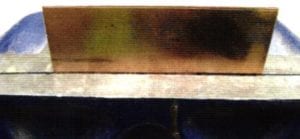 [/url]
Fig 15-a. In vice
Clamp the silver sheet in a bench vice so that the line of the silver sheet is close to the top line of the vice shoe. Bend the sheet over to a right angle. Use a mallet or soft hammer (Fig. 15).
[url=https://www.ganoksin.com/wp-content/uploads/2016/07/image_16-3.jpeg]
[/url]
Fig 15-a. In vice
Clamp the silver sheet in a bench vice so that the line of the silver sheet is close to the top line of the vice shoe. Bend the sheet over to a right angle. Use a mallet or soft hammer (Fig. 15).
[url=https://www.ganoksin.com/wp-content/uploads/2016/07/image_16-3.jpeg] [/url]
Fig 15-b. Bend over
To make the second bend-overlay the enameled piece close to the side of the bent corner. Set both together in such a way on the vice that one side of the enameled piece rests firmly against the bent edge of the framework. The other side of the enamel piece should rest at the front upper edge of the vice shoe (Fig. 16).
[url=https://www.ganoksin.com/wp-content/uploads/2016/07/image_17-2-1.jpeg]
[/url]
Fig 15-b. Bend over
To make the second bend-overlay the enameled piece close to the side of the bent corner. Set both together in such a way on the vice that one side of the enameled piece rests firmly against the bent edge of the framework. The other side of the enamel piece should rest at the front upper edge of the vice shoe (Fig. 16).
[url=https://www.ganoksin.com/wp-content/uploads/2016/07/image_17-2-1.jpeg]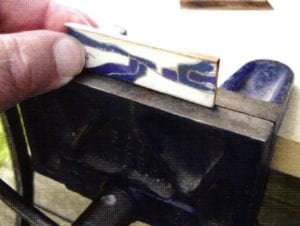 [/url]
Fig 16
Tighten the metal frame plate in the vice, remove the enamel piece and turn the frame work over to the right angle (Fig. 17).
[url=https://www.ganoksin.com/wp-content/uploads/2016/07/image_18-2-1.jpeg]
[/url]
Fig 16
Tighten the metal frame plate in the vice, remove the enamel piece and turn the frame work over to the right angle (Fig. 17).
[url=https://www.ganoksin.com/wp-content/uploads/2016/07/image_18-2-1.jpeg]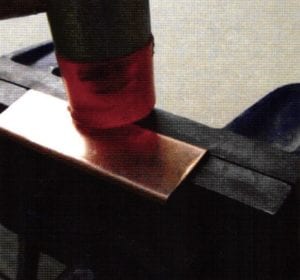 [/url]
Fig 17.
After bending both sides, examine whether the enamel piece fits. It should fit loosely but without play. If it is too large, grind away a bit from one side of the enamel piece. Now you can bend the two small sides to a 120 degree angle – a straight line folding stake (Fig. 18) is ideal for this.
[url=https://www.ganoksin.com/wp-content/uploads/2016/07/image_19-2-1.jpeg]
[/url]
Fig 17.
After bending both sides, examine whether the enamel piece fits. It should fit loosely but without play. If it is too large, grind away a bit from one side of the enamel piece. Now you can bend the two small sides to a 120 degree angle – a straight line folding stake (Fig. 18) is ideal for this.
[url=https://www.ganoksin.com/wp-content/uploads/2016/07/image_19-2-1.jpeg]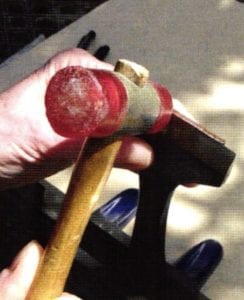 [/url]
Fig 18. Straight line folding stake to make 120 degree angle
If you don’t have one you can make one from a piece of band hoop or you can use the bit of a chisel. After bending, check out whether you can insert the enamel piece from one end of the metal frame. The enamel should slip in easy. If not, grind away a little part of one side of the enamel piece. Make sure the bent parts of the frame are only 0.5 mm higher than the enamel surface (Fig. 19).
[url=https://www.ganoksin.com/wp-content/uploads/2016/07/image_20-2-1.jpeg]
[/url]
Fig 18. Straight line folding stake to make 120 degree angle
If you don’t have one you can make one from a piece of band hoop or you can use the bit of a chisel. After bending, check out whether you can insert the enamel piece from one end of the metal frame. The enamel should slip in easy. If not, grind away a little part of one side of the enamel piece. Make sure the bent parts of the frame are only 0.5 mm higher than the enamel surface (Fig. 19).
[url=https://www.ganoksin.com/wp-content/uploads/2016/07/image_20-2-1.jpeg]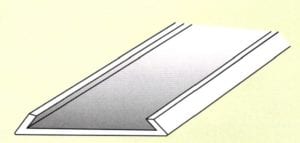 [/url]
Fig 19. 120 degree bend
Rivet the findings to the back as shown before. Instead of a needle bar pin you can rivet a loop to the back if you want to wear the enamel as a pendant (Fig. 20).
[url=https://www.ganoksin.com/wp-content/uploads/2016/07/image_21-2-1.jpeg]
[/url]
Fig 19. 120 degree bend
Rivet the findings to the back as shown before. Instead of a needle bar pin you can rivet a loop to the back if you want to wear the enamel as a pendant (Fig. 20).
[url=https://www.ganoksin.com/wp-content/uploads/2016/07/image_21-2-1.jpeg]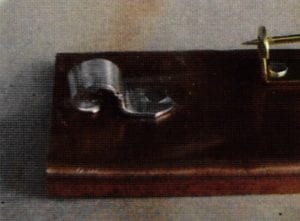 [/url]
Fig 20. Riveted loop
After riveting, go and polish the silver as usual. Round up all sharp corners. Put a bit of epoxy resin on the back of the enamel piece and push the enamel from the side into the frame. Remove excess epoxy and let the glue set up.
[/url]
Fig 20. Riveted loop
After riveting, go and polish the silver as usual. Round up all sharp corners. Put a bit of epoxy resin on the back of the enamel piece and push the enamel from the side into the frame. Remove excess epoxy and let the glue set up.
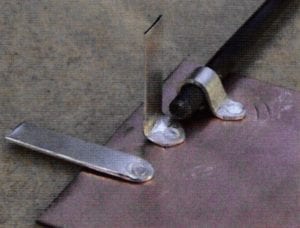 [/url]
Fig 21
Lay a 5 mm diameter iron, drill or the handle of a file tight to the right angle and press down the strip with a flat tool like a flat nosed pliers (Fig. 21 upper right side of photo and Fig. 22). If the strip is too long, shorten it a bit.
[url=https://www.ganoksin.com/wp-content/uploads/2016/07/image_23-1-1.jpeg]
[/url]
Fig 21
Lay a 5 mm diameter iron, drill or the handle of a file tight to the right angle and press down the strip with a flat tool like a flat nosed pliers (Fig. 21 upper right side of photo and Fig. 22). If the strip is too long, shorten it a bit.
[url=https://www.ganoksin.com/wp-content/uploads/2016/07/image_23-1-1.jpeg]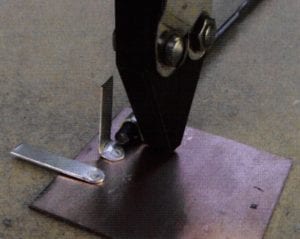 [/url]
Fig 22. Pressing down with flat-nosed pliers.
Drill a hole through strip and frame, widen the hole conical and rivet the loop and frame together (Fig. 23).
[url=https://www.ganoksin.com/wp-content/uploads/2016/07/image_24-1.jpeg]
[/url]
Fig 22. Pressing down with flat-nosed pliers.
Drill a hole through strip and frame, widen the hole conical and rivet the loop and frame together (Fig. 23).
[url=https://www.ganoksin.com/wp-content/uploads/2016/07/image_24-1.jpeg]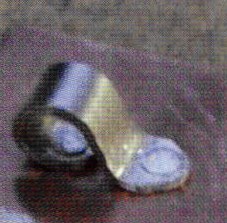 [/url]
Fig 23. Finished riveted loop
[url=https://www.ganoksin.com/wp-content/uploads/2016/07/image_25-1.jpeg]
[/url]
Fig 23. Finished riveted loop
[url=https://www.ganoksin.com/wp-content/uploads/2016/07/image_25-1.jpeg] [/url]
Fig 24. Finished bend over frames with enamels
[/url]
Fig 24. Finished bend over frames with enamels
[i]by[/i] [url=https://www.ganoksin.com/member/edmundmassow/]Edmund Massow[/url]
 [/url]
Fig 1. Bend over frame made from silver sheet
You can enamel directly onto the frame or you can use it to glue an enameled plate in. If you want to enamel directly to the frame, do not rivet the findings as the enamel may crack or pop off on or around the rivets.
[/url]
Fig 1. Bend over frame made from silver sheet
You can enamel directly onto the frame or you can use it to glue an enameled plate in. If you want to enamel directly to the frame, do not rivet the findings as the enamel may crack or pop off on or around the rivets.
 [/url]
Fig 2. Top: two identical plastic cut outs, Bottom left: shape transferred to metal with enlargement of shape traced onto metal; bottom right silver sheet.
Transfer the outline of one of the plastic shapes to a 0.7 – 0.8 mm fine silver sheet. Enlarge the size of the shape by adding an extra 2 – 3 mm to the outline or perimeter of the shape as this will become the bent over “frame” of the shape. (Fig. 2). If you want to enamel directly on the frame, you need only a rim height of about 1 mm. However, you will still need at a minimum 2 mm excess or you will not be able to bend it over. All types of shapes are possible with this technique, not only round or square (Fig. 3).
[url=https://www.ganoksin.com/wp-content/uploads/2016/07/image_3-28-1.jpeg]
[/url]
Fig 2. Top: two identical plastic cut outs, Bottom left: shape transferred to metal with enlargement of shape traced onto metal; bottom right silver sheet.
Transfer the outline of one of the plastic shapes to a 0.7 – 0.8 mm fine silver sheet. Enlarge the size of the shape by adding an extra 2 – 3 mm to the outline or perimeter of the shape as this will become the bent over “frame” of the shape. (Fig. 2). If you want to enamel directly on the frame, you need only a rim height of about 1 mm. However, you will still need at a minimum 2 mm excess or you will not be able to bend it over. All types of shapes are possible with this technique, not only round or square (Fig. 3).
[url=https://www.ganoksin.com/wp-content/uploads/2016/07/image_3-28-1.jpeg] [/url]
Fig 3. Various shapes made with this process
Make a ‘sandwich’ with one plastic sheet on either side of the silver sheet. Make sure the excess sticks out uniformly on all sides of the ‘sandwich.’ Clamp the ‘sandwich’ in a vice (Fig. 4).
[url=https://www.ganoksin.com/wp-content/uploads/2016/07/image_4-24-1.jpeg]
[/url]
Fig 3. Various shapes made with this process
Make a ‘sandwich’ with one plastic sheet on either side of the silver sheet. Make sure the excess sticks out uniformly on all sides of the ‘sandwich.’ Clamp the ‘sandwich’ in a vice (Fig. 4).
[url=https://www.ganoksin.com/wp-content/uploads/2016/07/image_4-24-1.jpeg] [/url]
Fig 4. Sandwich clamped in vice
Hammer the silver rim excess over with a mallet or other ‘soft’ hammer to one side of the plastic sheet. Try not to bend the rim over in one step, do this in about three steps so the rim doesn’t build up folds (Fig. 5).
[url=https://www.ganoksin.com/wp-content/uploads/2016/07/image_5-22-1.jpeg]
[/url]
Fig 4. Sandwich clamped in vice
Hammer the silver rim excess over with a mallet or other ‘soft’ hammer to one side of the plastic sheet. Try not to bend the rim over in one step, do this in about three steps so the rim doesn’t build up folds (Fig. 5).
[url=https://www.ganoksin.com/wp-content/uploads/2016/07/image_5-22-1.jpeg] [/url]
Fig 5. Hammering over excess metal to make frame
Remove the silver sheet from the plastic. File away the little folds, other roughness and the top of the rim as needed. If you are going to enamel directly on the silver frame, file down the rim to a height of about 0.8 to 0.9 mm.
If you want to make a pendant, drill a hole in the silver sheet. If the work piece is to be stoned after enameling, it is best to dome the metal frame a bit. Do not dome on a dapping block, but on a stake.
If you want to make a brooch, now is the time to solder the findings on the back. If you are not comfortable soldering, do the following: If you want to glue round ‘footed’ findings (Fig. 6), lay two round, formed silver rings made from one mm fine or sterling silver wire to the back of the work piece frame.
[url=https://www.ganoksin.com/wp-content/uploads/2016/07/image_6-16-1.jpeg]
[/url]
Fig 5. Hammering over excess metal to make frame
Remove the silver sheet from the plastic. File away the little folds, other roughness and the top of the rim as needed. If you are going to enamel directly on the silver frame, file down the rim to a height of about 0.8 to 0.9 mm.
If you want to make a pendant, drill a hole in the silver sheet. If the work piece is to be stoned after enameling, it is best to dome the metal frame a bit. Do not dome on a dapping block, but on a stake.
If you want to make a brooch, now is the time to solder the findings on the back. If you are not comfortable soldering, do the following: If you want to glue round ‘footed’ findings (Fig. 6), lay two round, formed silver rings made from one mm fine or sterling silver wire to the back of the work piece frame.
[url=https://www.ganoksin.com/wp-content/uploads/2016/07/image_6-16-1.jpeg] [/url]
Fig 6. Applying enamel around silver rings
Apply wet enamel to the back. The enamel must fasten the rings from the outside, keeping the inside of the rings free from enamel (Fig. 6). After drying, fire the enamel. Now you can enamel the front side. After all enameling is done, glue the findings into the rings (Fig. 7).
[url=https://www.ganoksin.com/wp-content/uploads/2016/07/image_7-13-1.jpeg]
[/url]
Fig 6. Applying enamel around silver rings
Apply wet enamel to the back. The enamel must fasten the rings from the outside, keeping the inside of the rings free from enamel (Fig. 6). After drying, fire the enamel. Now you can enamel the front side. After all enameling is done, glue the findings into the rings (Fig. 7).
[url=https://www.ganoksin.com/wp-content/uploads/2016/07/image_7-13-1.jpeg] [/url]
Fig 7. Finding glued into ring
Because the rings are very small, it would be easier to use a commercially manufactured bar pin (Fig. 8). For these, make a little rectangular box shape from silver wire and secure with enamel as explained above, again, keeping the inside of the box free of enamel. These wire rings and boxes have no technical function, their function is to make a more finished look to the back.
[url=https://www.ganoksin.com/wp-content/uploads/2016/07/image_8-11-1.jpeg]
[/url]
Fig 7. Finding glued into ring
Because the rings are very small, it would be easier to use a commercially manufactured bar pin (Fig. 8). For these, make a little rectangular box shape from silver wire and secure with enamel as explained above, again, keeping the inside of the box free of enamel. These wire rings and boxes have no technical function, their function is to make a more finished look to the back.
[url=https://www.ganoksin.com/wp-content/uploads/2016/07/image_8-11-1.jpeg] [/url]
Fig 8. Commercial bar pins
If you don’t want to glue findings onto the frame, you can make rivet findings. Most of the commercially made bar pins have two holes in the base plate. If they do not, you will have to drill them yourself. Transfer the hole placement on the bar pin to match them to the metal frame. For brooches, the findings (bar pins) should always be fastened in the upper third of the brooch, otherwise the brooch will fall in front when it is worn.
[url=https://www.ganoksin.com/wp-content/uploads/2016/07/image_9-6-1.jpeg]
[/url]
Fig 8. Commercial bar pins
If you don’t want to glue findings onto the frame, you can make rivet findings. Most of the commercially made bar pins have two holes in the base plate. If they do not, you will have to drill them yourself. Transfer the hole placement on the bar pin to match them to the metal frame. For brooches, the findings (bar pins) should always be fastened in the upper third of the brooch, otherwise the brooch will fall in front when it is worn.
[url=https://www.ganoksin.com/wp-content/uploads/2016/07/image_9-6-1.jpeg] [/url]
Fig 9. Conical drill hole for riveting
Both the holes of the bar pin and the frame plate must have the same diameter as the wire you make the rivets from. To give the rivets more bearing surface, drill holes conical with a ball drill bit. (Fig. 9). Drill out half of the frame metal sheet and the bar pin finding plate thickness.
[url=https://www.ganoksin.com/wp-content/uploads/2016/07/image_10-5.jpeg]
[/url]
Fig 9. Conical drill hole for riveting
Both the holes of the bar pin and the frame plate must have the same diameter as the wire you make the rivets from. To give the rivets more bearing surface, drill holes conical with a ball drill bit. (Fig. 9). Drill out half of the frame metal sheet and the bar pin finding plate thickness.
[url=https://www.ganoksin.com/wp-content/uploads/2016/07/image_10-5.jpeg] [/url]
Fig 10. Melt both wire ends to a ball
Cut a 3 cm long round fine silver wire. The wire must have the same diameter as the drill holes in both the metal plates (bar pin finding and frame metal plate). Melt both wire ends to a small ball and divide the wire in the center (Fig. 10). File the top 2/3 off of both balls (Fig.11).
[url=https://www.ganoksin.com/wp-content/uploads/2016/07/image_11-5.jpeg]
[/url]
Fig 10. Melt both wire ends to a ball
Cut a 3 cm long round fine silver wire. The wire must have the same diameter as the drill holes in both the metal plates (bar pin finding and frame metal plate). Melt both wire ends to a small ball and divide the wire in the center (Fig. 10). File the top 2/3 off of both balls (Fig.11).
[url=https://www.ganoksin.com/wp-content/uploads/2016/07/image_11-5.jpeg] [/url]
Fig 11. File top of ball, rivet
Align the bar pin finding holes to the holes on the metal frame.
[url=https://www.ganoksin.com/wp-content/uploads/2016/07/image_12-5.jpeg]
[/url]
Fig 11. File top of ball, rivet
Align the bar pin finding holes to the holes on the metal frame.
[url=https://www.ganoksin.com/wp-content/uploads/2016/07/image_12-5.jpeg] [/url]
Fig 12. Thread rivet through finding and bolt frames
Thread the rivet(s) through the bar pin holes so that the rivet head is needle side of the bar pin finding and the wire is protruding through the hole(s) in the silver metal frame. Cut the wire so that only about 0.5 mm is protruding above the silver metal frame. Place the rivet head onto a hard base. Rivet the wire first with the hammer fin, then with the flat side of the hammer.
[url=https://www.ganoksin.com/wp-content/uploads/2016/07/image_13-4.jpeg]
[/url]
Fig 12. Thread rivet through finding and bolt frames
Thread the rivet(s) through the bar pin holes so that the rivet head is needle side of the bar pin finding and the wire is protruding through the hole(s) in the silver metal frame. Cut the wire so that only about 0.5 mm is protruding above the silver metal frame. Place the rivet head onto a hard base. Rivet the wire first with the hammer fin, then with the flat side of the hammer.
[url=https://www.ganoksin.com/wp-content/uploads/2016/07/image_13-4.jpeg] [/url]
Fig 13. Inner side of brooch frame with conical drilled hole and a bit of rivet on right side and on the left, the finished rivet
Hammer the rivet until the finding and silver frame are absolutely tight together. Now you can glue in the enamel work into the bent over frame.
[/url]
Fig 13. Inner side of brooch frame with conical drilled hole and a bit of rivet on right side and on the left, the finished rivet
Hammer the rivet until the finding and silver frame are absolutely tight together. Now you can glue in the enamel work into the bent over frame.
 [/url]
Fig 14
You can use fine silver or a silver alloy about 0.5-0.7 mm thick for the frame. Transfer the outside lines of the finished enamel to the silver sheet. On the two opposite straight sides you need an extra of about the thickness of the finished enamel plus about 0.5 to 0.7 mm. For example: if the enamel is 2 mm thick, you need2 mm + 0.7 mm :2.7 mm extra on each straight side.
[url=https://www.ganoksin.com/wp-content/uploads/2016/07/image_15-3-1.jpeg]
[/url]
Fig 14
You can use fine silver or a silver alloy about 0.5-0.7 mm thick for the frame. Transfer the outside lines of the finished enamel to the silver sheet. On the two opposite straight sides you need an extra of about the thickness of the finished enamel plus about 0.5 to 0.7 mm. For example: if the enamel is 2 mm thick, you need2 mm + 0.7 mm :2.7 mm extra on each straight side.
[url=https://www.ganoksin.com/wp-content/uploads/2016/07/image_15-3-1.jpeg] [/url]
Fig 15-a. In vice
Clamp the silver sheet in a bench vice so that the line of the silver sheet is close to the top line of the vice shoe. Bend the sheet over to a right angle. Use a mallet or soft hammer (Fig. 15).
[url=https://www.ganoksin.com/wp-content/uploads/2016/07/image_16-3.jpeg]
[/url]
Fig 15-a. In vice
Clamp the silver sheet in a bench vice so that the line of the silver sheet is close to the top line of the vice shoe. Bend the sheet over to a right angle. Use a mallet or soft hammer (Fig. 15).
[url=https://www.ganoksin.com/wp-content/uploads/2016/07/image_16-3.jpeg] [/url]
Fig 15-b. Bend over
To make the second bend-overlay the enameled piece close to the side of the bent corner. Set both together in such a way on the vice that one side of the enameled piece rests firmly against the bent edge of the framework. The other side of the enamel piece should rest at the front upper edge of the vice shoe (Fig. 16).
[url=https://www.ganoksin.com/wp-content/uploads/2016/07/image_17-2-1.jpeg]
[/url]
Fig 15-b. Bend over
To make the second bend-overlay the enameled piece close to the side of the bent corner. Set both together in such a way on the vice that one side of the enameled piece rests firmly against the bent edge of the framework. The other side of the enamel piece should rest at the front upper edge of the vice shoe (Fig. 16).
[url=https://www.ganoksin.com/wp-content/uploads/2016/07/image_17-2-1.jpeg] [/url]
Fig 16
Tighten the metal frame plate in the vice, remove the enamel piece and turn the frame work over to the right angle (Fig. 17).
[url=https://www.ganoksin.com/wp-content/uploads/2016/07/image_18-2-1.jpeg]
[/url]
Fig 16
Tighten the metal frame plate in the vice, remove the enamel piece and turn the frame work over to the right angle (Fig. 17).
[url=https://www.ganoksin.com/wp-content/uploads/2016/07/image_18-2-1.jpeg] [/url]
Fig 17.
After bending both sides, examine whether the enamel piece fits. It should fit loosely but without play. If it is too large, grind away a bit from one side of the enamel piece. Now you can bend the two small sides to a 120 degree angle – a straight line folding stake (Fig. 18) is ideal for this.
[url=https://www.ganoksin.com/wp-content/uploads/2016/07/image_19-2-1.jpeg]
[/url]
Fig 17.
After bending both sides, examine whether the enamel piece fits. It should fit loosely but without play. If it is too large, grind away a bit from one side of the enamel piece. Now you can bend the two small sides to a 120 degree angle – a straight line folding stake (Fig. 18) is ideal for this.
[url=https://www.ganoksin.com/wp-content/uploads/2016/07/image_19-2-1.jpeg] [/url]
Fig 18. Straight line folding stake to make 120 degree angle
If you don’t have one you can make one from a piece of band hoop or you can use the bit of a chisel. After bending, check out whether you can insert the enamel piece from one end of the metal frame. The enamel should slip in easy. If not, grind away a little part of one side of the enamel piece. Make sure the bent parts of the frame are only 0.5 mm higher than the enamel surface (Fig. 19).
[url=https://www.ganoksin.com/wp-content/uploads/2016/07/image_20-2-1.jpeg]
[/url]
Fig 18. Straight line folding stake to make 120 degree angle
If you don’t have one you can make one from a piece of band hoop or you can use the bit of a chisel. After bending, check out whether you can insert the enamel piece from one end of the metal frame. The enamel should slip in easy. If not, grind away a little part of one side of the enamel piece. Make sure the bent parts of the frame are only 0.5 mm higher than the enamel surface (Fig. 19).
[url=https://www.ganoksin.com/wp-content/uploads/2016/07/image_20-2-1.jpeg] [/url]
Fig 19. 120 degree bend
Rivet the findings to the back as shown before. Instead of a needle bar pin you can rivet a loop to the back if you want to wear the enamel as a pendant (Fig. 20).
[url=https://www.ganoksin.com/wp-content/uploads/2016/07/image_21-2-1.jpeg]
[/url]
Fig 19. 120 degree bend
Rivet the findings to the back as shown before. Instead of a needle bar pin you can rivet a loop to the back if you want to wear the enamel as a pendant (Fig. 20).
[url=https://www.ganoksin.com/wp-content/uploads/2016/07/image_21-2-1.jpeg] [/url]
Fig 20. Riveted loop
After riveting, go and polish the silver as usual. Round up all sharp corners. Put a bit of epoxy resin on the back of the enamel piece and push the enamel from the side into the frame. Remove excess epoxy and let the glue set up.
[/url]
Fig 20. Riveted loop
After riveting, go and polish the silver as usual. Round up all sharp corners. Put a bit of epoxy resin on the back of the enamel piece and push the enamel from the side into the frame. Remove excess epoxy and let the glue set up.
 [/url]
Fig 21
Lay a 5 mm diameter iron, drill or the handle of a file tight to the right angle and press down the strip with a flat tool like a flat nosed pliers (Fig. 21 upper right side of photo and Fig. 22). If the strip is too long, shorten it a bit.
[url=https://www.ganoksin.com/wp-content/uploads/2016/07/image_23-1-1.jpeg]
[/url]
Fig 21
Lay a 5 mm diameter iron, drill or the handle of a file tight to the right angle and press down the strip with a flat tool like a flat nosed pliers (Fig. 21 upper right side of photo and Fig. 22). If the strip is too long, shorten it a bit.
[url=https://www.ganoksin.com/wp-content/uploads/2016/07/image_23-1-1.jpeg] [/url]
Fig 22. Pressing down with flat-nosed pliers.
Drill a hole through strip and frame, widen the hole conical and rivet the loop and frame together (Fig. 23).
[url=https://www.ganoksin.com/wp-content/uploads/2016/07/image_24-1.jpeg]
[/url]
Fig 22. Pressing down with flat-nosed pliers.
Drill a hole through strip and frame, widen the hole conical and rivet the loop and frame together (Fig. 23).
[url=https://www.ganoksin.com/wp-content/uploads/2016/07/image_24-1.jpeg] [/url]
Fig 23. Finished riveted loop
[url=https://www.ganoksin.com/wp-content/uploads/2016/07/image_25-1.jpeg]
[/url]
Fig 23. Finished riveted loop
[url=https://www.ganoksin.com/wp-content/uploads/2016/07/image_25-1.jpeg] [/url]
Fig 24. Finished bend over frames with enamels
[/url]
Fig 24. Finished bend over frames with enamels